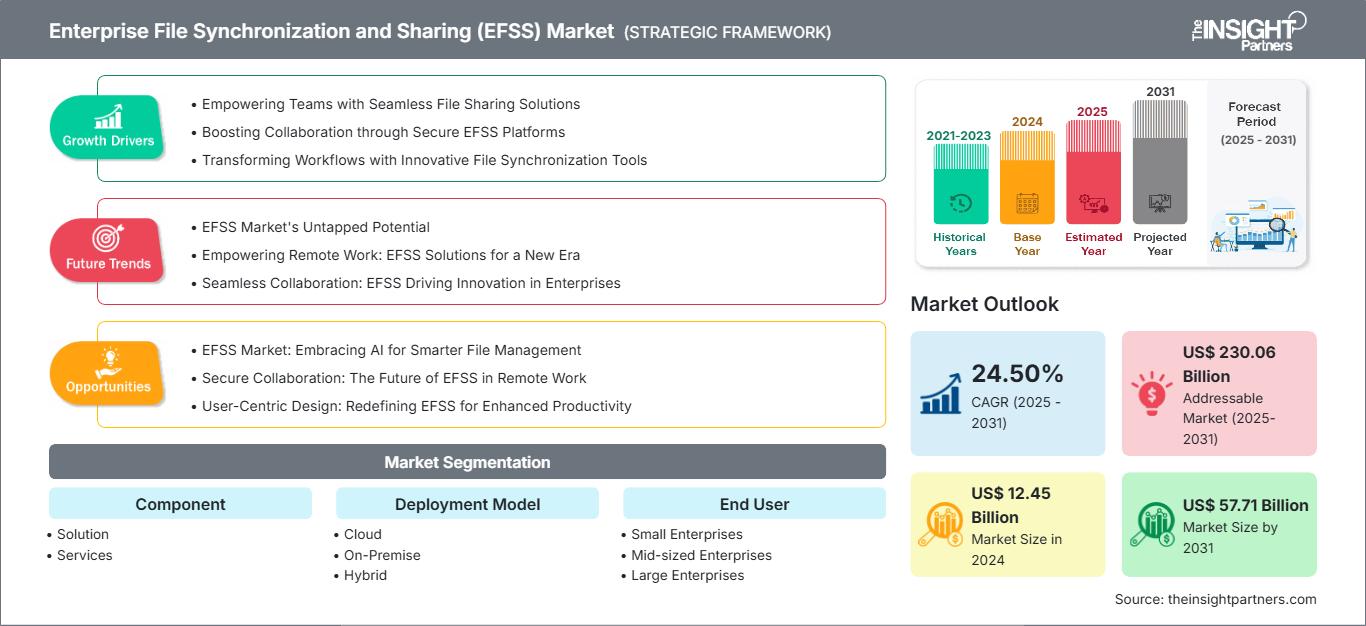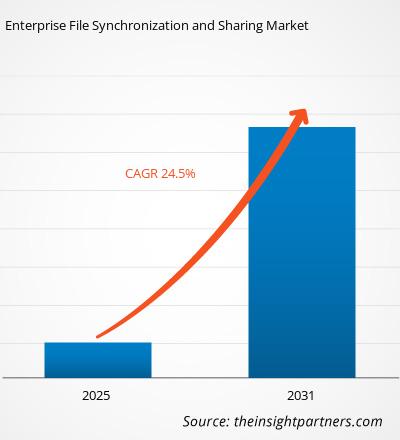Si prevede che il mercato della sincronizzazione e condivisione dei file aziendali (EFSS) registrerà un CAGR del 24,50% dal 2025 al 2031, con una dimensione del mercato in espansione da 12,45 miliardi di dollari nel 2024 a 57,71 miliardi di dollari entro il 2031.
Il rapporto è suddiviso in base ai componenti (soluzioni, servizi) e analizza ulteriormente il mercato in base al modello di distribuzione (cloud, on-premise, ibrido). Esamina inoltre il mercato per utente finale (piccole imprese, medie imprese, grandi imprese) e settore verticale (sanità e scienze della vita, BFSI, IT e telecomunicazioni, media e intrattenimento, beni di consumo e vendita al dettaglio, beni industriali e automotive). Per ciascuno di questi segmenti chiave viene fornita una ripartizione completa a livello globale, regionale e nazionale.
Il rapporto include dimensioni e previsioni di mercato per tutti i segmenti, presentando i valori in dollari statunitensi. Fornisce inoltre statistiche chiave sullo stato attuale del mercato dei principali attori, insieme ad approfondimenti sulle tendenze di mercato prevalenti e sulle opportunità emergenti.
Scopo del rapporto
Il rapporto "Enterprise File Synchronization and Sharing (EFSS) Market" di The Insight Partners mira a descrivere il panorama attuale e la crescita futura, i principali fattori trainanti, le sfide e le opportunità. Questo fornirà spunti di riflessione a diversi stakeholder aziendali, tra cui:
- Fornitori/produttori di tecnologia: per comprendere le dinamiche di mercato in evoluzione e conoscere le potenziali opportunità di crescita, consentendo loro di prendere decisioni strategiche informate.
- Investitori: per condurre un'analisi completa delle tendenze in merito al tasso di crescita del mercato, alle proiezioni finanziarie del mercato e alle opportunità esistenti lungo la catena del valore.
- Enti di regolamentazione: regolamentano le politiche e le attività di controllo sul mercato con l'obiettivo di ridurre al minimo gli abusi, preservare la fiducia degli investitori e sostenere l'integrità e la stabilità del mercato.
Segmentazione del mercato della sincronizzazione e condivisione dei file aziendali (EFSS)
Componente
- Soluzione
- Servizi
Modello di distribuzione
- Nuvola
- In sede
- Ibrido
Utente finale
- Piccole imprese
- Imprese di medie dimensioni
- Grandi imprese
Settore verticale
- Assistenza sanitaria e scienze della vita
- BFSI
- IT e telecomunicazioni
- Media e intrattenimento
- Beni di consumo e vendita al dettaglio
- Beni industriali e automobilistici
Riceverai la personalizzazione gratuita di qualsiasi report, incluse parti di questo report, analisi a livello nazionale, pacchetto dati Excel e potrai usufruire di fantastiche offerte e sconti per start-up e università.
Mercato della sincronizzazione e condivisione dei file aziendali (EFSS): approfondimenti strategici

- Scopri le principali tendenze di mercato di questo rapporto.Questo campione GRATUITO includerà analisi dei dati, che spaziano dalle tendenze di mercato alle stime e alle previsioni.
Fattori di crescita del mercato della sincronizzazione e condivisione dei file aziendali (EFSS)
- Fornire ai team soluzioni di condivisione file senza interruzioni
- Potenziare la collaborazione attraverso piattaforme EFSS sicure
- Trasformare i flussi di lavoro con strumenti innovativi di sincronizzazione dei file
Tendenze future del mercato della sincronizzazione e condivisione dei file aziendali (EFSS)
- Il potenziale inutilizzato del mercato EFSS
- Potenziare il lavoro a distanza: soluzioni EFSS per una nuova era
- Collaborazione senza soluzione di continuità: EFSS guida l'innovazione nelle imprese
Opportunità di mercato per la sincronizzazione e la condivisione dei file aziendali (EFSS)
- Mercato EFSS: adottare l'intelligenza artificiale per una gestione più intelligente dei file
- Collaborazione sicura: il futuro dell'EFSS nel lavoro da remoto
- Progettazione incentrata sull'utente: ridefinire EFSS per una maggiore produttività
Approfondimenti regionali sul mercato della sincronizzazione e condivisione dei file aziendali (EFSS)
Le tendenze e i fattori regionali che hanno influenzato il mercato della sincronizzazione e condivisione di file aziendali (EFSS) durante il periodo di previsione sono stati ampiamente spiegati dagli analisti di The Insight Partners. Questa sezione illustra anche i segmenti e la geografia del mercato della sincronizzazione e condivisione di file aziendali (EFSS) in Nord America, Europa, Asia-Pacifico, Medio Oriente e Africa, America meridionale e centrale.
Ambito del rapporto di mercato sulla sincronizzazione e condivisione dei file aziendali (EFSS)
| Attributo del report | Dettagli |
|---|---|
| Dimensioni del mercato nel 2024 | 12,45 miliardi di dollari USA |
| Dimensioni del mercato entro il 2031 | 57,71 miliardi di dollari USA |
| CAGR globale (2025 - 2031) | 24,50% |
| Dati storici | 2021-2023 |
| Periodo di previsione | 2025-2031 |
| Segmenti coperti | Per componente
|
| Regioni e paesi coperti | America del Nord
|
| Leader di mercato e profili aziendali chiave |
|
Densità degli operatori del mercato della sincronizzazione e condivisione dei file aziendali (EFSS): comprendere il suo impatto sulle dinamiche aziendali
Il mercato della sincronizzazione e condivisione di file aziendali (EFSS) è in rapida crescita, trainato dalla crescente domanda degli utenti finali, dovuta a fattori quali l'evoluzione delle preferenze dei consumatori, i progressi tecnologici e una maggiore consapevolezza dei vantaggi del prodotto. Con l'aumento della domanda, le aziende stanno ampliando la propria offerta, innovando per soddisfare le esigenze dei consumatori e sfruttando le tendenze emergenti, alimentando ulteriormente la crescita del mercato.

- Ottieni una panoramica dei principali attori del mercato della sincronizzazione e condivisione dei file aziendali (EFSS)
Punti di forza chiave
- Copertura completa: il rapporto copre in modo completo l'analisi di prodotti, servizi, tipologie e utenti finali del mercato EFSS (Enterprise File Synchronization and Sharing), fornendo un panorama olistico.
- Analisi degli esperti: il rapporto è redatto sulla base della conoscenza approfondita di esperti e analisti del settore.
- Informazioni aggiornate: il rapporto garantisce la pertinenza aziendale grazie alla copertura delle informazioni più recenti e delle tendenze dei dati.
- Opzioni di personalizzazione: questo report può essere personalizzato per soddisfare le esigenze specifiche del cliente e adattarsi in modo appropriato alle strategie aziendali.
Il rapporto di ricerca sul mercato della sincronizzazione e condivisione di file aziendali (EFSS) può quindi contribuire a tracciare un percorso di decodifica e comprensione dello scenario e delle prospettive di crescita del settore. Sebbene possano esserci alcune valide preoccupazioni, i vantaggi complessivi di questo rapporto tendono a superare gli svantaggi.
- Analisi storica (2 anni), anno base, previsione (7 anni) con CAGR
- Analisi PEST e SWOT
- Valore/volume delle dimensioni del mercato - Globale, Regionale, Nazionale
- Industria e panorama competitivo
- Set di dati Excel
Report recenti
Testimonianze
Motivo dell'acquisto
- Processo decisionale informato
- Comprensione delle dinamiche di mercato
- Analisi competitiva
- Analisi dei clienti
- Previsioni di mercato
- Mitigazione del rischio
- Pianificazione strategica
- Giustificazione degli investimenti
- Identificazione dei mercati emergenti
- Miglioramento delle strategie di marketing
- Aumento dell'efficienza operativa
- Allineamento alle tendenze normative




















 Ottieni un campione gratuito per - Mercato della sincronizzazione e condivisione dei file aziendali (EFSS)
Ottieni un campione gratuito per - Mercato della sincronizzazione e condivisione dei file aziendali (EFSS)